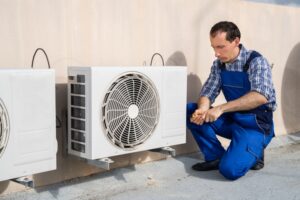“My second floor it too hot!”
When you live in a two-story home, you probably say that a lot during the scorching summer months. On the first floor, you’re completely comfortable, but the moment you go upstairs, you start to sweat. Maybe your entire family even sleeps downstairs to ensure a good night’s rest.
This is a normal summertime phenomenon that you can generally blame on thermodynamics. When your HVAC system cools off the first floor, hot air will ‘float’ upward, resulting in a warmer second floor. Many homeowners try to deal with the problem by lowering the thermostat temperature and leaving the A/C running all day only to come home to a frigid first floor and a second one that is still uncomfortably warm.
You could always cool the second floor by adding a supplemental system to it or redesigning the home’s entire duct system, but both take time and cost money. Fortunately, there are other solutions that are easy and / or cost-effective. Here are four of them.
1. Close Blinds and drapes
The morning sun may brighten up a room, but it also raises indoor temperatures. Your thermostat is probably controlled on the first floor, so this pooling heat upstairs won’t signal your HVAC system to kick in. To keep temperatures cooler, close the blinds and drapes to add an extra level of insulation around your windows.
2. Partially close the registers on the first floor
If you have a basement, you can push more cool airflow up to the second floor by locating the dampers on your ducts and closing them at least halfway. If you can’t find the dampers or don’t have a basement, you can partially close the vents on your first floor register to achieve the same effect.
By slightly restricting airflow to the first floor, the volume of cool air to your second floor is increased. Your HVAC system cycle times will also become longer (presuming your thermostat is on the first floor), which also helps push cool air to the second floor. For maximum efficacy, make sure that your air-return vents are open and nothing blocks your vents upstairs.
3. Use ceiling fans
Stagnant air feels warmer, so improving air circulation upstairs will increase comfort levels. If your home is wired to accommodate a ceiling fan, installing one in your upstairs bedrooms is a lot more cost-effective than a complete duct redesign.
4. Ensure that the attic is well-insulated
Your attic has a significant impact on your second floor comfort levels. It traps hot air and, throughout the day, becomes a lot warmer than the outdoor temperature. When the barrier between your attic and second floor is minimal, the heat seeps through into your home.
Good attic insulation will reduce the amount of hot air that reaches your second floor. You should also keep your attic as well-ventilated as possible to eliminate heat and moisture levels.
And if this doesn’t work….
If proper attic insulation and partially closing your first-floor vents does not improve comfort on the second floor, there may be an issue with your HVAC system. In that case, call a trained and qualified technician who can troubleshoot any problems and get your system back in good working order.






